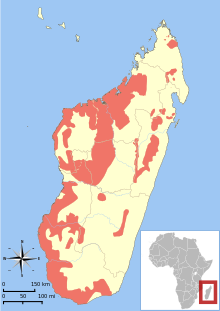Sifaka
| Sifakas | |
|---|---|
 |
|
| Coquerel's sifaka (P. coquereli) | |
| Scientific classification | |
| Kingdom: | Animalia |
| Phylum: | Chordata |
| Class: | Mammalia |
| Order: | Primates |
| Suborder: | Strepsirrhini |
| Family: | Indriidae |
| Genus: |
Propithecus Bennett, 1832 |
| Type species | |
|
Propithecus diadema Bennett, 1832 |
|
| Diversity | |
| 9 species | |
 |
|
| Combined distribution of Propithecus | |
| Synonyms | |
|
|
Sifakas (singular "sifaka"; ![]() i/ʃɪˈfɑːk/; Malagasy pronunciation: [ˈsifakə̥]) are a genus (Propithecus) of lemur from the family Indriidae within the order Primates. The name of their family is an onomatopoeia of their characteristic "shi-fak" alarm call. Like all lemurs, they are found only on the island of Madagascar. All species of sifakas are threatened, ranging from vulnerable to critically endangered.
i/ʃɪˈfɑːk/; Malagasy pronunciation: [ˈsifakə̥]) are a genus (Propithecus) of lemur from the family Indriidae within the order Primates. The name of their family is an onomatopoeia of their characteristic "shi-fak" alarm call. Like all lemurs, they are found only on the island of Madagascar. All species of sifakas are threatened, ranging from vulnerable to critically endangered.
Sifakas are medium-sized indrids with a head and body length of 40 to 55 centimetres (16 to 22 in) and a weight of 3 to 6 kilograms (6.6 to 13.2 lb). Their tail is just as long as their body, which differentiates them from the Indri. Their fur is long and silky, with coloration varying by species from yellowish-white to black brown. The round, hairless face is always black. As with all lemurs, the sifaka has special adaptations for grooming, including a toilet-claw on its second toe and a toothcomb.
...
Wikipedia
